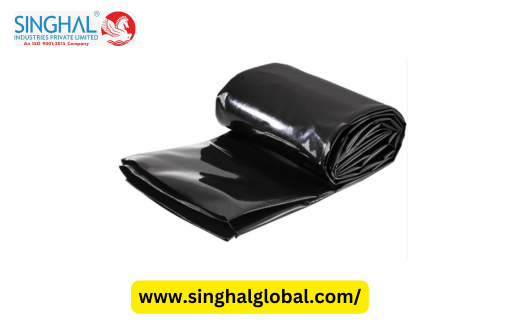Revolutionizing Construction with Geotextiles and Geomembranes A Comprehensive Guide

Geomembrane sheets play a vital role in a wide range of industries, offering exceptional durability and environmental protection. From construction to agriculture, these versatile materials are critical for various applications like containment, water management, and soil protection. As a result, Geomembrane sheet suppliers have become key partners in delivering high-quality solutions that ensure sustainability and cost-effectiveness.
This article will explore the importance of geomembrane sheets, factors influencing the Geomembrane sheet price, and how geotextiles and geomembranes work together in modern infrastructure projects.
What Are Geomembrane Sheets?
A geomembrane sheet is a low-permeability barrier used to control fluid or gas migration in infrastructure projects. These sheets are typically made from materials such as high-density polyethylene (HDPE), linear low-density polyethylene (LLDPE), and polyvinyl chloride (PVC). Due to their excellent resistance to chemicals, punctures, and UV degradation, geomembrane sheets are widely used in applications like landfills, mining, water reservoirs, and waste containment.
Importance of Quality in Geomembrane Sheets
Choosing the right Geomembrane sheet suppliers is essential because low-quality products can compromise a project's success. The key attributes of a high-quality geomembrane sheet include:
- Durability: The material should withstand harsh environmental conditions and long-term exposure to chemicals and UV light.
- Flexibility: Geomembrane sheets should be flexible enough to conform to various surfaces and site conditions.
- Impermeability: High impermeability ensures that the sheet acts as an effective barrier against liquids or gases, preventing leaks and contamination.
By selecting reliable suppliers, companies can ensure that they receive products that meet industry standards and contribute to the longevity and safety of their projects.
Factors Affecting Geomembrane Sheet Price
The Geomembrane sheet price can vary depending on several factors:
- Material Composition: HDPE and LLDPE geomembrane sheets are typically more expensive than PVC due to their higher chemical resistance and durability.
- Thickness: Thicker sheets offer more durability and are often preferred for high-stress applications. However, they also come at a higher cost.
- Application: Customization and specific applications such as specialized coatings or reinforcements can increase the price.
- Supplier Quality: Trusted and experienced Geomembrane sheet suppliers may charge a premium for their products, but they also offer better warranties, customer service, and technical support.
Investing in high-quality geomembranes can lead to long-term savings, as low-cost materials may require frequent replacements or repairs.
The Relationship Between Geotextiles and Geomembranes
While geomembranes are impermeable sheets designed to act as barriers, geotextiles are fabric-like materials that provide filtration, reinforcement, and separation in construction projects. When used together, geotextiles and geomembranes create an advanced system for erosion control, drainage, and containment.
- Erosion Control: By combining a geomembrane with a geotextile, engineers can create systems that prevent soil erosion and minimize environmental damage. The geotextile helps to stabilize the soil, while the geomembrane acts as a barrier to stop water or waste from seeping through.
- Drainage Systems: Geotextiles and geomembranes work together to facilitate proper water flow in drainage systems, preventing blockages and improving water management in urban and rural environments.
- Waste Containment: For landfills and waste management facilities, a geomembrane layer prevents contaminants from leaching into the surrounding soil, while the geotextile enhances the overall stability and efficiency of the containment system.
Applications of Geomembrane Sheets and Geotextiles
Geomembrane sheets and geotextiles are essential in various sectors, each with unique requirements:
- Landfills: Geomembranes prevent toxic waste from contaminating the groundwater, while geotextiles reinforce the structure.
- Water Reservoirs: These sheets offer impermeable barriers to ensure no water leakage, making them ideal for water conservation.
- Agriculture: Geomembranes can be used in ponds or irrigation systems to store water and prevent seepage, reducing water waste.
- Mining: Geomembrane sheets protect the environment by containing hazardous materials, such as chemical leachates, and ensuring that they do not affect the surrounding land.
How to Choose the Right Geomembrane Sheet Suppliers
Finding the right Geomembrane sheet suppliers is crucial for the success of any project. Here are some key points to consider when choosing a supplier:
- Product Range: The supplier should offer a wide variety of geomembranes and related materials like geotextiles. This ensures you have access to the best materials for your specific project.
- Quality Assurance: Ensure that the supplier adheres to industry standards and certifications for quality. This guarantees the material's durability and suitability for your project.
- Technical Support: Suppliers who provide technical support and guidance can be invaluable, especially when dealing with large-scale projects.
- Cost and Value: While price is important, focus on the long-term value that high-quality products can bring to your project.
Conclusion
Geomembrane sheets are indispensable for modern infrastructure, providing durability, impermeability, and flexibility across a range of applications. When combined with geotextiles, they create a powerful solution for erosion control, drainage, and waste containment. Choosing the right Geomembrane sheet suppliers ensures that you receive quality products that meet your project's needs and contribute to long-term success.
Here are Three Related for Geomembrane sheet suppliers
1. What factors affect the price of geomembrane sheets?
Ans: The Geomembrane sheet price depends on the material type, thickness, supplier quality, and specific application needs like custom coatings.
2. How do geotextiles and geomembranes work together?
Ans: Geotextiles and geomembranes complement each other by providing soil reinforcement, drainage, and impermeability, enhancing the overall efficiency of projects.
3. What industries use geomembrane sheets?
Ans: Geomembrane sheets are used in agriculture, construction, landfills, mining, and water management for containment and protection.
- Questions and Answers
- Opinion
- Motivational and Inspiring Story
- Technology
- Live and Let live
- Focus
- Geopolitics
- Military-Arms/Equipment
- Security
- Economy
- Beasts of Nations
- Machine Tools-The “Mother Industry”
- Art
- Causes
- Crafts
- Dance
- Drinks
- Film/Movie
- Fitness
- Food
- Games
- Gardening
- Health
- Home
- Literature
- Music
- Networking
- Other
- Party
- Religion
- Shopping
- Sports
- Theater
- Health and Wellness
- News
- Culture

